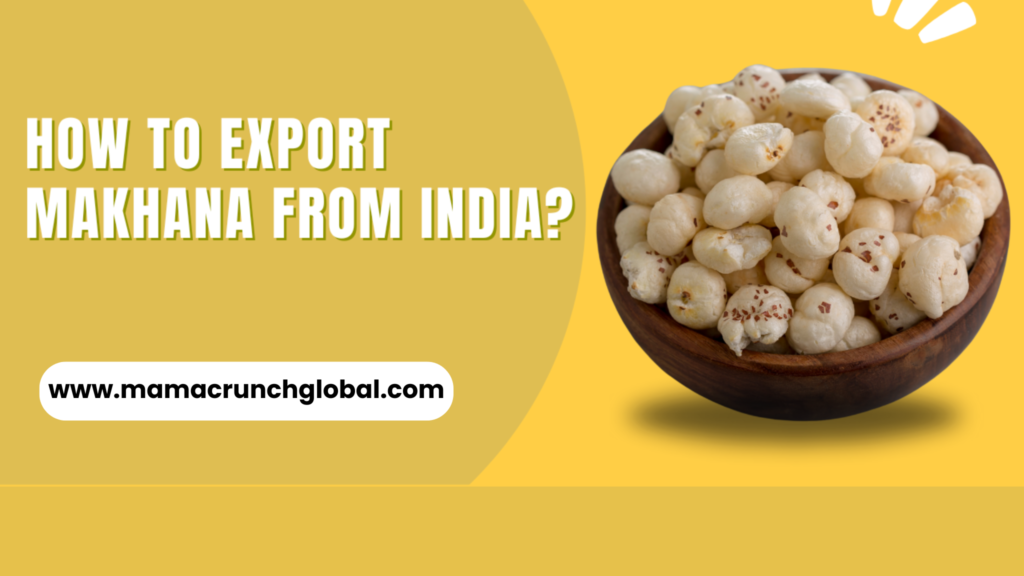For effective international trade, quick delivery, and high-quality products, choosing a trustworthy Makhana supplier for export is essential. How to Find a Reliable Makhana Supplier for Export Because of its many uses and nutritional advantages, makhana, often referred to as fox nuts, has become quite popular in international markets. You can choose the best provider for your company’s requirements with the aid of this advice.

Understanding the Makhana Industry
Why is Makhana in Demand?
- Makhana is widely consumed as a healthy snack.
- High in protein and low in calories.
- Suitable for gluten-free and vegan diets.
- Increasing global demand, especially in health-conscious regions.
Major Makhana Producing Regions
- The biggest producer of makhana is Bihar, India.
- portions of Nepal and Eastern India.
- Sustainable agricultural methods are becoming more and more popular.
- How to Locate a Trustworthy Makhana Provider.
Identify Your Requirements
- Establish the supply’s quantity and frequency.
- Indicate the necessary certifications (such as organic certification) and the quality of the goods.
- Select your preferred labels and packaging.
Research Potential Suppliers
- Make use of internet markets such as ExportHub, Alibaba, and IndiaMART.
- Attend food events and international trade shows.
- Make connections with trade groups such as the Agricultural and Processed Food Products Export Development Authority, or APEDA.
Evaluate Supplier Credibility
- Look for certificates such as ISO, HACCP, and FSSAI.
- Check the supplier’s exporting experience in the markets you want to reach.
- To guarantee consistency in quality, ask for sample products.
Assess Pricing and Payment Terms
- Examine quotes from several vendors.
- Discuss discounts for large orders.
- Use escrow services or banks to guarantee safe payment procedures.
Check Logistics and Delivery Support
Confirm the supplier’s capacity to handle international shipping.
Assess packaging standards for maintaining product freshness.
Inquire about delivery timelines and tracking options.
Negotiate Contracts and Agreements
- Draft a clear contract outlining pricing, quality standards, and delivery schedules.
- Include dispute resolution clauses.
- Ensure both parties are aligned on payment and refund policies.
- Tips for Long-Term Supplier Relationships
- Maintain transparent communication.
- Conduct regular quality checks.
- Build partnerships through fair trade practices.
- Collaborate on marketing initiatives.
How to Find a Reliable Makhana Supplier for Export
Makhana, sometimes referred to as lotus seeds or fox nuts, is a very wholesome and adaptable snack that has become very popular in recent years. How to Find a Reliable Makhana Supplier for Export Originally from India, makhana is now popular throughout the world because of its many health advantages, such as being high in protein, low in calories, and high in antioxidants. Finding a trustworthy source is essential if you want to export Makhana in order to guarantee quality, consistency, and prompt delivery. This blog will walk you through the steps of finding and collaborating with a reliable Makhana export provider.
Define Your Requirements
- Before contacting suppliers, clearly state your needs. Take into account the following elements:
- Quantity: Calculate how much Makhana you will require for export.
- Quality Standards: Indicate the quality standards, including moisture content, colour, and size.
- Packaging: Choose the necessary packaging, such as retail-ready packets or bulk packaging.
Research Potential Suppliers
- Investigate possible providers first, both online and off. The following are some efficient methods for locating Makhana suppliers:
- Online B2B platforms: A large number of Makhana suppliers are listed on websites such as Alibaba, IndiaMART, and TradeIndia. You may read reviews, compare costs, and get in touch with providers directly using these platforms.
- Exhibitions and Trade events: Go to trade events for agriculture and food where Makhana suppliers display their goods. This gives you the chance to meet providers face-to-face and evaluate what they have to offer.
- Industrial Associations: For suggestions, get in touch with the agricultural boards or industrial associations in the areas that produce Makhana.
- Local Networks: To establish connections with regional farmers and suppliers, try to travel to areas that produce makhana, such as Bihar.
Evaluate Supplier Credentials
- Once you’ve narrowed down your list of possible providers, check their qualifications to make sure they’re trustworthy.
- Experience: Seek out vendors who have worked in the Makhana sector for several years.
- Certifications: Confirm that the supplier possesses the required safety and quality certificates.
- Production Capacity: Verify that the provider can fulfill your demands for volume without sacrificing quality.
- Export Experience: Find out if the supplier has exported Makhana to your target market before.
- References: To assess a company’s reputation and dependability, ask for references from prior customers.
Request Samples
- Ask for samples of the Makhana items from potential suppliers before choosing one. Assess the samples in light of:
- Quality: Verify that the texture, colour, and size are all consistent.
- Taste: Verify that the Makhana suits your palate.
- Packaging: Evaluate the packaging’s appearance and longevity.
- Moisture level: Make sure the goods are adequately dried because a high moisture level can cause spoilage while in transportation.
Negotiate Terms and Conditions
- Discuss the terms and conditions with the supplier when you’re happy with the samples. Important topics to talk about include:
- Pricing: Work out a reasonable and competitive price.
- Payment Terms: Determine whether to use a letter of credit, advance payment, or payment upon delivery.
- Delivery Schedule: Verify if the supplier can fulfil your deadlines.
- Minimum Order Quantity (MOQ): Verify the MOQ to see whether it meets your needs.
- Contract: To prevent misunderstandings, draft a thorough contract that includes all terms and conditions.
Conduct a Factory Audit
- Do a factory audit at the supplier’s location if at all possible. This will assist you in evaluating:
- Production Process: Verify that the production procedure satisfies hygienic and quality requirements.
- Storage Facilities: To avoid contamination or spoiling, make sure the storage facilities are sufficient.
- Employees: Assess the employees’ working circumstances.
- Compliance: Confirm adherence to national and international laws.
Build a Long-Term Relationship
- A trustworthy supplier is a great ally for your export company. Put your attention on creating a lasting partnership by:
- Keeping in Touch: Keep in touch frequently to quickly resolve any problems.
- Giving Feedback: Provide comments regarding the caliber of the goods and the effectiveness of the delivery.
- Investigating Collaboration: Look into potential joint ventures, including creating new products using Makhana.
Consider Logistics and Documentation
- Managing paperwork and logistics is part of exporting Makhana. Make sure your supplier is able to help with:
- Export Documentation: Provide the required paperwork, such as packing lists, invoices, and origin certificates.
- Shipping Plans: Work with logistics partners to arrange for economical and prompt shipping.
- Customs Clearance: Verify that the supplier is knowledgeable about the laws governing customs in your intended market.
Conclusion
It takes careful investigation, assessment, and negotiation to find a trustworthy Makhana source for export. You may choose a reliable provider who satisfies your needs for quantity, quality, and price by following the instructions in this blog. In addition to guaranteeing the prosperity of your export company, a solid alliance with a trustworthy supplier will enable you to take advantage of the expanding demand for Makhana around the world.
Keep in mind that prompt delivery, quality, and consistency are essential for a successful export firm. You’ll be well on your way to starting a successful Makhana export company if you take the time to cultivate a solid relationship with your supplier.
